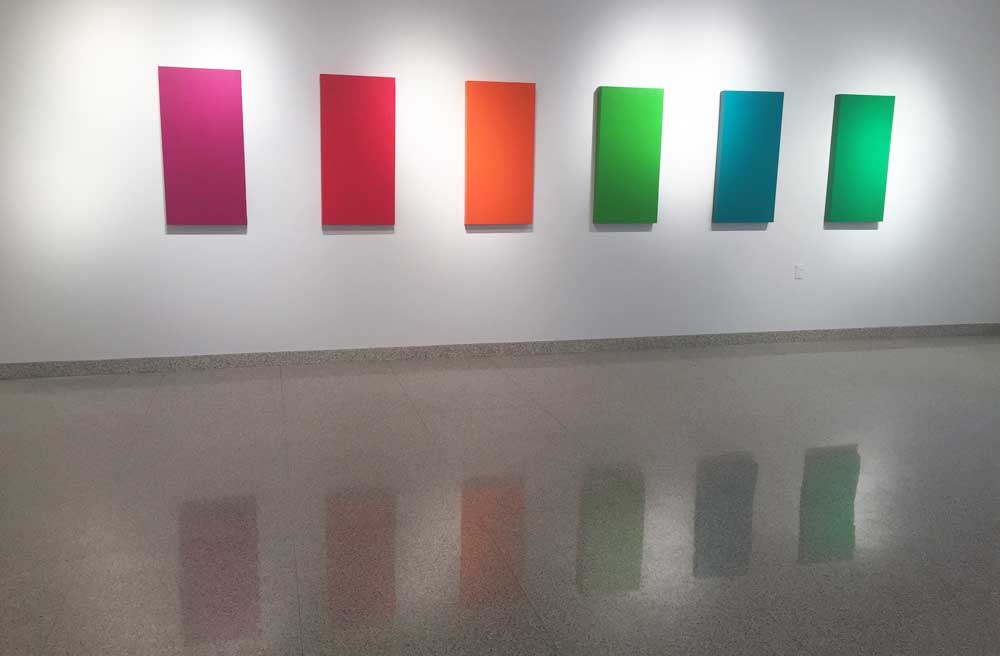« Reviews
Siri Berg: In Color
Shirley Fiterman Art Center - New York
Curated by Peter Hionas
By Kim Power
Joseph Albers, artist and author of the groundbreaking book Interaction of Color (1963), once said, “Colors influence and change each other forth and back. They continuously interact-in our perception.”
Siri Berg’s solo exhibition “In Color” at Shirley Fiterman Art Center, curated by Peter Hionas of Hionas Gallery, presents a mini retrospective of a life spent examining this very premise, with more than 70 artworks on display. In a career spanning some 30 years, Berg’s works have been included in the permanent collections of the Guggenheim Museum, New York; Southwest State University Art Museum, New Mexico; Cornell University’s Herbert F. Johnson Museum of Art, Ithaca, N.Y.; and the Museum of Modern Art, Stockholm, where she was born.

Siri Berg, In Color (installation View), 2016. Courtesy of Hionas Gallery and Shirley Fiterman Art Center, BMCC.
In a reverse time line the exhibition begins with six large rectangular panels, evenly spaced, named for their local colors, Purple, Red, Orange, Light Green, Aqua Blue and Dark Green (all created in 2015). Color fields that can be placed in any order, these six panels set the tone for all the other works, as if they are the genesis and not terminus of her explorations, reducing color to its most minimal characteristics and allowing it to be experienced solely on the merits of its factual existence alone. Refreshing as this display might be, it also has the potential for the mundane, and so the mind wanders into subjective query.
Berg presents color like a mathematician proving a theorem. It is formulaic, sectioned and divided, arranged and rearranged in a myriad of possible combinations, in a simplified geometry of space, color and value relationships. The deliberate and conscious way Berg disassembles and reassembles the same problem takes on the characteristics of a Zen koan, in that it becomes not about the question itself, but about the process of questioning.
Take Berg’s Straight Line 1-3 (1999) series of three small square paintings. Berg has utilized the highly chromatic orange, red and purple seen in her larger panels, isolated on a thin strip across the top uniting each square. Below, a wider parallel strip from the same series is painted in darker earth tones. Sandwiched in between, from left to right, is a wide band of vertical rectangles: pale pastels in the first, more neutral earth tones in the second and in the third, the same neutrals are embellished with a stucco-like paint surface. If these colors were assigned numbers, they would appear as a simple divisional equation with the added variable of texture. I can almost hear it in my head: If red is to orange as pink is to brown-the probable combinations are endless.
In Berg’s earlier figure/ground explorations Phases - Works on Paper (1974) and Progressions #3 (1974) sectioned circles wax and wane like phases of the moon. Laid out in five-by-five rows on graph paper, the shapes are described in a thinly cut tape. The second work sees them filled in orange marker dn colored pencil, while the third completes the cycle, filling in the background with turquoise. These works along with others such as Bottom Circle (1970), a smaller circle resting inside a larger one, reiterate the prioritization of shape and color of the Bauhaus period as well as Kandinsky’s design sensibility, without straying from the origin of its influences.
Berg doesn’t take on a lot of risks in her works. They are largely a calculated examination of principles laid down by artists like Joseph Albers and utilized by many artists of the early 1970s, and in that sense they are perhaps not entirely remarkable. What is perhaps noteworthy is the dedication to purpose with which Berg has single-mindedly focused all her artistic energy. In a world of distractions where chaos reigns, these seemingly simple, minimalistic and, yes, at times monotonous works, take on the aspects of a quiet revolution.
(November 17, 2016 - February 4, 2017)
Kim Power is an international artist and writer currently residing in The Bronx. She holds a B.S. in Art Education from James Madison University and a Master in Fine Arts in painting from the New York Academy of Art. Her reviews have been published through The Brooklyn Rail, Arte Fuse, and Quantum Art Review.
Filed Under: Reviews



































Leave a Reply
You must be logged in to post a comment.